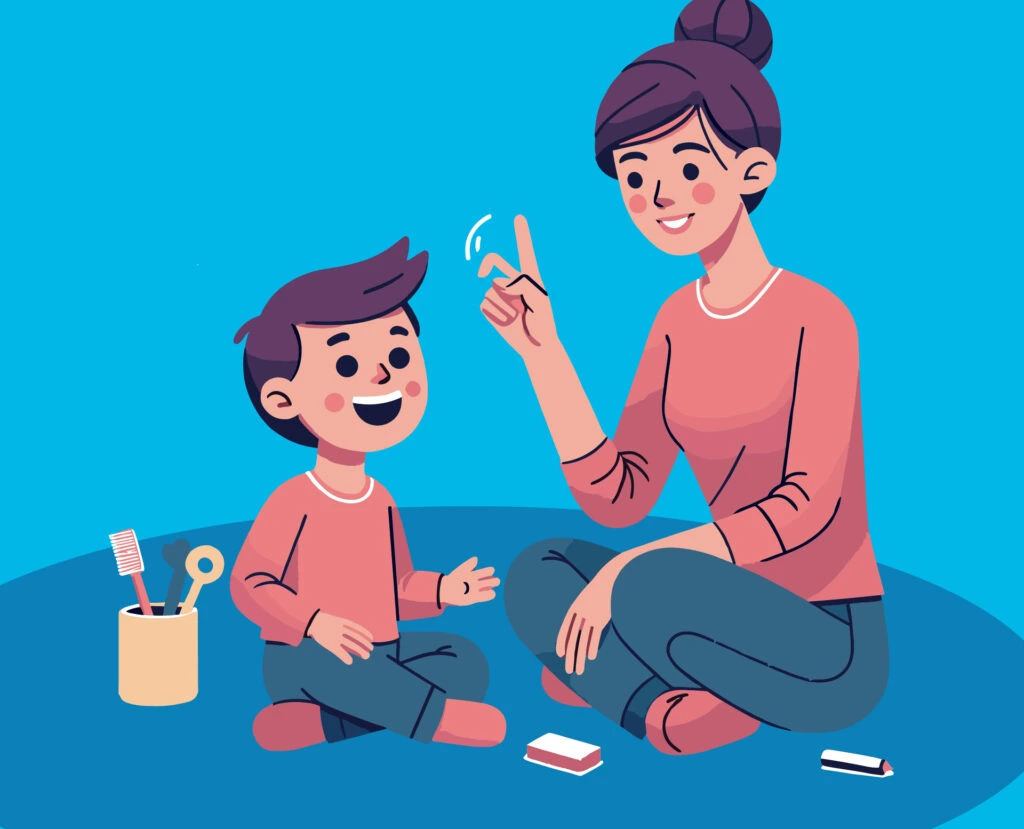By Pranali Shah MS, CF SLP
Imitation is a remarkable ability that plays a significant role in a child’s development. From their earliest days, children are natural mimics, imitating the sounds, gestures, and expressions of the people around them. This innate tendency to imitate is more than just cute behavior; it’s a crucial building block for developing their speech and language skills.
Imitation can begin as early as 8 months old and it typically develops in a sequential manner. Below is the manner that imitation typically develops and some examples of how to help your child prompt imitation.
- Child imitates actions with objects such as:
- Throwing a ball
- Popping balloons
- Shaking a rattle
- Banging blocks
- Removing a blanket during peek-a-boo
- Stacking blocks and knocking them over
- Brushing a dolls hair, feeding or washing the doll
- Child imitates communicative gestures such as:
- Clapping your hands or stomping your feet during a song
- Dancing
- Animal movements
- Communicative gestures can also include:
- Reaching to be lifted
- Waving
- Clapping
- Blowing kisses
- High fives
- Shaking head yes/no
- Pointing
- Hand motions for songs and finger play
- Imitating oral movements and nonverbal actions with your face and mouth such as:
-
- Opening/closing mouth
- Raising eyebrows
- Making silly faces
- Puffing out cheeks
- Smiling
- Pouting
- Blowing bubbles
- Licking lips, puckering lips, pretending to lick
- Wiggling tongue, clicking tongue
-
- Vocalizations in play and imitating environmental sounds such as:
- Saying “ahh” in a bucket
- Panting like a dog
- Screaming or squealing
- Grunting
- Yawning
- Fake coughing, sneezing
- Making car truck noises, siren noises
- Fake laughing/crying
- Whining
- Snoring
- Making animal sounds
- Saying “Shhh” for quiet
- Exclamatory words and “fun” words that require a lot of emphasis and intonation, such as:
- Mmm,mmm
- Yum yum
- Yucky
- Yay
- Ouch
- Booo
- Oops, whoops
- Oh
- Wow
- Woo hoo
- Pow
- Hooray
- Aw man
- Oh no
- Speech in verbal routines
- Give your child pauses in songs, social games, phrases to complete the sentence, such as:
- Ready, set, go
- Peek-a-boo
- Patty cake
- Give me 5
- Ride little horsie
- Row your boat
- Ring around the rosies
- Songs such as: twinkle twinkle, itsy bitsy spider, wheels on the bus
- Give your child pauses in songs, social games, phrases to complete the sentence, such as:
- Functional words such as:
- All done
- Baby
- Ball
- Banana
- Bye bye, hi
- More
- Mama, papa
- Short phrases such as:
- My ___
- More ___
- ____ please
- More please
- Bye bye ____
- Hi ___
- Night night ___
- It’s easiest to combine words from your child’s already-established vocabulary
One of the best ways to practice language learning is to master the 8 stages of language learning. These stages can be practiced during play, feeding, and even bedtime routines.
Information taken from Laura Mize, M.S. CCC-SLP (teachmetotalk.com)
Mize, L. (2011). Building Verbal Imitation in Toddlers. In Teach me to talk: The therapy manual ; a comprehensive guide for treating receptive and expressive language delays and disorders in toddlers and young preschoolers. essay, Teachmetotalk.com.




